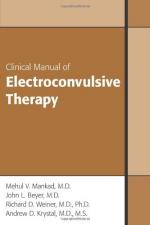|
This section contains 840 words (approx. 3 pages at 300 words per page) |

|
Electroconvulsive therapy (ECT) was developed in the 1930s as an alternative to psychiatric treatments that depended on inducing a convulsion. More recently, ECT has been reviewed and evaluated by scientific groups in several countries, and has been found to be a safe and effective treatment for severe and disabling depression. The therapeutic effect is caused by a brain seizure, not a convulsion visible in the limbs. In contemporary practice, ECT is administered in conjunction with a short-acting general anesthetic and a muscle relaxant. As a result, the seizure is most easily detected by recording brain waves during treatment. ECT can be either bilateral, in which case one electrode is applied to each side of the head, or unilateral, in which case two electrodes are applied to the right side of the head. The benefit of ECT is evaluated by considering...
|
This section contains 840 words (approx. 3 pages at 300 words per page) |

|


